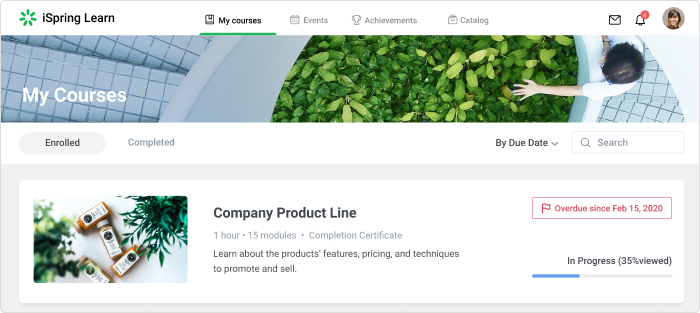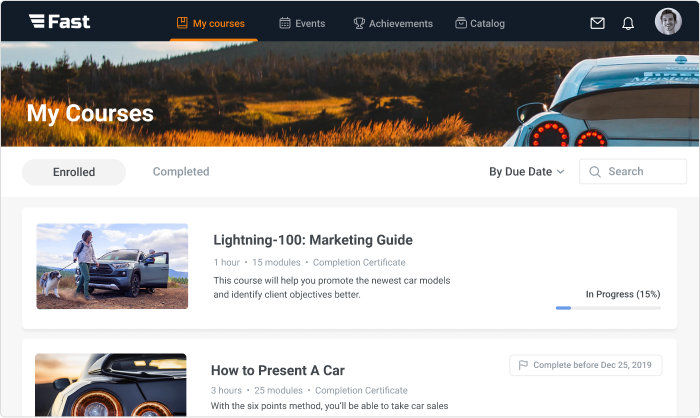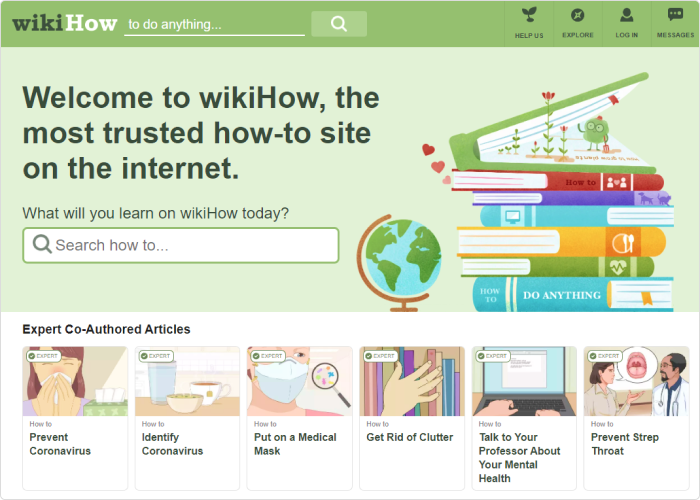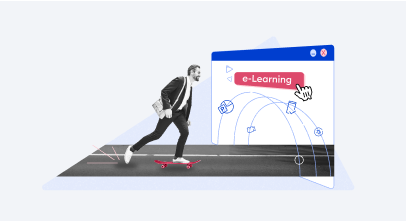Asynchronous Learning Explained: Everything You Need to Know

Asynchronous learning involves self-paced training activities that learners take when it’s convenient for them from anywhere in the world. It doesn’t involve getting immediate feedback, nor does it require attendance at a scheduled time.
In recent years, asynchronous learning has become an increasingly popular educational approach, especially as the landscape of online learning continues to evolve, and many people prefer to complete an degree program online instead of going the traditional in-person route. According to data from the National Center for Education Statistics, approximately 60% of undergraduate students were enrolled in at least one distance education course, reflecting a significant shift towards online and hybrid learning models.
In this article, you’ll learn what asynchronous learning is and see not just its benefits but also its drawbacks, how it compares to synchronous learning, and how both methods can be used to meet diverse educational needs effectively.
What is Asynchronous Learning?
Asynchronous learning is the educational approach wherein students access learning content, complete assessments, and communicate with instructors at their convenience. This method does not require students to be in the same physical location or even to interact with a teacher or coach in real time.
As relaxed as this might appear, asynchronous learning does not imply an open-ended learning process. It might very well have strict deadlines and often specific outcomes, such as course completion, scores, or certifications. The greatest advantage of this learning method is the freedom it offers students to choose the learning approach and schedule.

Facilitators of asynchronous training don’t control their learners’ daily training routines, but they usually watch the deadlines closely.
4 Examples of Asynchronous Learning
Having left snail mail correspondence courses in the past, asynchronous learning environments now mostly exist in digital format.
1. eLearning
eLearning is the most advanced type of asynchronous learning. Being a computer or web-based training program, it usually requires a learning platform where facilitators upload training content, and where learners sign in to see what was assigned to them.
Using such learning platforms has an undeniable advantage: the learning process can be automated, at least to some extent. For example, you can create an online program in which a learner unlocks some content only after having completed the preceding units. Or, the platform can automatically manage deadlines, as well as send reminders to those who are falling behind.

Using an LMS is the most convenient way to manage web-based learning.
Also, you’ll need an authoring tool to create eLearning courses to fill the platform with high-quality content: interactive e-courses, assessments, audio files, and video lectures.
As for the cost, you need to be ready for some investments when launching eLearning. For reference, a bundle containing iSpring LMS and the iSpring Suite authoring tool will cost you $4.46 per month (far not the highest price on the market) for 300 active learners, billed annually. Yet, for some companies, buying a platform for eLearning and an authoring tool may seem too pricey, but this is, perhaps, the only way to get the maximum out of asynchronous training.
2. Email courses
An email course is just a sequence of emails that cover a certain topic. Each email is one lesson, and all of them make up a course.
In addition to writing content for each lesson of a course, you also need to think about two things:
- How are you going to gather your learners’ email addresses?
- How will you deliver training into their inbox?
For the first thing, you’ll need a mailing-list database. If you’re going to train your employees, you likely already have their work emails or can easily get them from intranet or HRs. Otherwise, you’ll need a website with a subscription form. If you don’t have it yet, you can explore online services for code-free website creation such as Tilda or Readymag.
As for the second, we wouldn’t recommend even trying to send each email manually as well as sending out mass emails. These are bad ideas, just take our word. What you’ll need is an email marketing service (have a look at Mailchimp or GetResponse). Such a service will allow you to automate the whole process and also track performance and create better content as you go.

Creating an email course is an affordable way to show off your expertise.
Of course, not every topic can be fully covered or taught from scratch by means of email. You won’t be able to deliver interactive tasks right in the mailbox, since email course content mostly consists of text. But what is a disadvantage for one, can be an advantage for others. Email courses can be a good choice if you’re looking for a budget-friendly alternative to full-fledged eLearning and don’t need any bells and whistles.
3. Training video
As we’ve already said, using a learning management system is often the most convenient way to manage training content, including training videos. At the same time, you can simply upload your video lessons on YouTube and share the link with everyone to whom you deem it useful.
See also: Instructional Video Made Easy: Tips, Hacks & Tools

Workout DVDs are still popular. This is a sort of asynchronous training, too.
4. Blogs, wikis, and other readings
A wiki is a web resource that is created, supported, and updated by multiple users. The most famous example is Wikipedia, the world’s largest digital encyclopedia. At the same time, many companies have their own internal wikis that serve as a knowledge base in particular fields.

A wiki on how to do, well, anything
Unlike wikis, that everyone can contribute to, there is usually an editorial team that works on a blog. For inspiration, have a look at Open, the Buffer’s fantastic internal blog.
The main issue with this type of asynchronous learning that often occurs is low user engagement, so it’s better to know the answers to these questions before you start:
- Will the users be willing to contribute?
- Why would anyone read articles in the blog or wiki?
- How will I draw attention to the content?
Benefits of Asynchronous Learning
There are three main reasons why learning and development specialists choose asynchronous learning:
1. It provides more flexibility to learners
Allowing your learners to self-study at their own pace and at the time they choose makes dealing with their busy schedules much easier, as well as facilitating your own. Some people are early birds; others can only study late at night when all the work is done and the children are sleeping. Asynchronous learning covers it all.
It also supports different learning styles, so you can try tailoring an optimal experience for each learner. The same goes for training people with disabilities. Not only can you accommodate whether the learners are visual or audial types but design accessible learning, to begin with.
2. It can be easily scaled
Once you have created your asynchronous training content, you can use it as many times as necessary without additional work. Or, at least, you can focus on getting feedback and improving it. If you’ve recorded a video tutorial on how to use a popcorn machine, all you need to do is to share a link, not re-record it again and again if there are new employees.
Plus, with the asynchronous format, there is no big difference whether you train five people or five hundred. The content works to the same extent in both cases. This leads us to the next advantage.
3. It’s often more cost-effective than classroom training
Brick-and-mortar sessions are expensive, especially if your team is large. It’s even more expensive if the team is also remote.
With asynchronous learning, it is the opposite. The more learners you have, the lower the cost of the course per head. Let’s say you spent $1000 to develop an e-course. If there are 10 learners, the cost per view is $100; but if you have a thousand learners or more, its cost is under $1.
The Pitfalls of Asynchronous Learning
Not every skill can be taught asynchronously or online in general. No one would like to have an operation done by a surgeon whose only training was through online courses. But aside from such extreme examples, there are few things that require consideration when deciding on asynchronous learning.
1. Communication and feedback
Since self-paced learning occurs in a, well, self-paced mode you need to think beforehand how you’re going to provide students with feedback. Will there be performance reviews on a regular basis? Will you ask learners to do an assignment by a certain deadline? Or maybe your course doesn’t require giving feedback to users at all?
The other side of the issue is that you wouldn’t want your learners to feel isolated. How will you address questions the learners may have? Will there be forums, groups, or other social elements so that they can discuss topics and you could, therefore, grow a community?
2. Learner engagement
In an ideal world, all the learners are self-starters who don’t need anything more than just the opportunity to learn something. In reality, especially in a digital one, there are plenty of detractors competing for people’s attention.
Unlike in-person classes, during which an instructor can gauge learners’ reactions and provide additional explanations if needed, asynchronous online classes require careful planning to maintain student engagement.
See also: How to Make Your Online Course Interactive: Full How-to (and Why) Guide
Online Learning: Asynchronous vs. Synchronous
When it comes to online learning, understanding the difference between synchronous and asynchronous methods is crucial to choosing the best approach for your needs. Instructional design informs us that both offer unique advantages, and the right choice depends on your learning style, schedule, and goals.
Online asynchronous courses
Asynchronous online learning, as we’ve seen, offers learners the flexibility to engage with course material at their own pace. This mode of learning is ideal for working professionals with busy schedules or for learners who thrive on self-directed study. Whether it’s watching pre-recorded lectures, completing assignments on a flexible timeline, or participating in discussion boards, asynchronous courses cater to individuals who prefer to learn independently and at the times that suit them best.
Asynchronous courses shine in their ability to accommodate different learning styles. For instance, in an asynchronous learning environment, visual learners can review video content, while those who prefer reading can dive into course materials as desired. This adaptability not only makes learning more accessible, but also more personalized.
Online synchronous courses
In contrast, synchronous learning means that participants engage in learning activities simultaneously. Synchronous online learning is closer to traditional or physical classroom experiences, with scheduled sessions in which learners and instructors meet in person in real time, albeit virtually. Think of online classes, live webinars, group discussion posts, or virtual classroom meetings — these are all examples of synchronous classes.
Synchronous courses are particularly beneficial for those learners who value immediate feedback and real-time interaction with peers and instructors. This approach can foster a sense of community and enhance engagement, as participants can ask questions, collaborate on group work, and receive instant clarification on complex topics. Additionally, synchronous learning can create a more structured learning environment, which some learners may find motivational.
Asynchronous learning vs. Synchronous learning: Which one to choose?
When deciding between asynchronous and synchronous learning, it’s essential to weigh the advantages of each based on your specific needs and circumstances.
Flexibility vs. structure
Asynchronous learning environments are unmatched in terms of flexibility. They allow you to study instructional materials at your own pace, making it ideal for those with irregular schedules or individuals who need to balance online learning with other commitments. On the other hand, synchronous online classes provide a more structured environment, which can be beneficial for those who thrive on routine and the discipline of set schedules.
Self-Paced Learning vs. Real-Time Interaction
If you prefer taking your time to absorb information, asynchronous courses are the way to go. They allow you to pause, rewind, and revisit class materials as needed. However, if you value the opportunity to interact with instructors and peers in real time, synchronous learning offers the advantage of immediate feedback and the ability to engage in dynamic discussions.
Community Building vs. Independence
Synchronous learning fosters a sense of community and camaraderie. The real-time nature of this format allows for stronger connections between participants who come together in person at the same place and time, which can enhance the overall learning experience. Conversely, asynchronous learning environments appeal to independent learners who enjoy the freedom of exploring topics on their own, without the need for continuous interaction.
Cost and Scalability
From a logistical perspective, asynchronous learning environments are often more cost-effective and scalable. Once content is created, it can be reused indefinitely, making it easier to train large groups of learners without additional costs. Synchronous learning, while potentially more engaging, can require more resources — especially in terms of scheduling and hosting live sessions — and is only available with smaller groups.
So, the choice between synchronous and asynchronous learning depends largely on the preferences, lifestyles, and goals of both students and instructors — what gives them the best chance to achieve student success.
For those who require flexibility and prefer a self-directed approach, asynchronous learning offers better opportunities. However, if your learners thrive on in-person interaction and appreciate real-time feedback, synchronous learning environments might be more suitable. Ultimately, the best approach could be a blend of both, allowing your learners to enjoy the benefits of each format.
Conclusion
Asynchronous learning benefits both learners and teachers by eliminating limits created by schedules and the human factor. It’s often more affordable, especially if your team is large. It’s also a great opportunity to make learning inclusive. These are feasible arguments to give such a training delivery method a try.
At the same time, it’s unlikely technology alone can ever replace the skills and experience an instructor employs to create effective learning. But who’s ever said you must stick to just one training delivery method?
What do you think about asynchronous learning? Can it beat live classes? Please share your opinion in the comments below!




